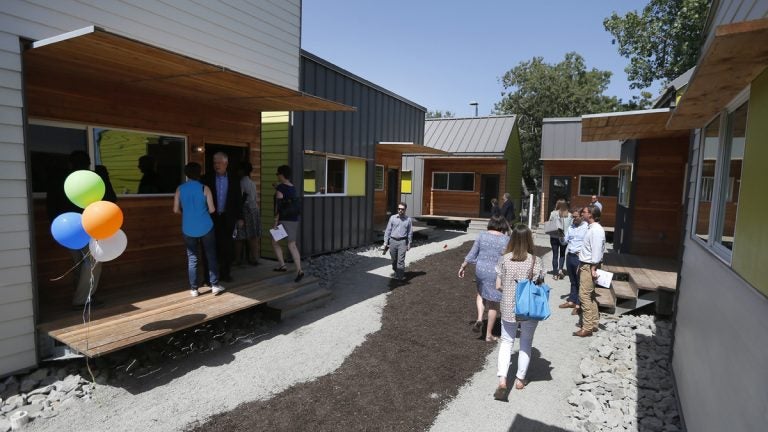New Jersey may consider tiny houses for the homeless

Guest tour tiny houses in Dallas
The “tiny house” movement that has millennials and baby boomers squeezing their lives into one- or two-room homes may be on the verge of putting down roots in New Jersey, but for a very different purpose.
A bill (S-2110) that would create three pilot “tiny house” projects across the state to provide places to live for New Jersey’s homeless and poor has begun moving through the Legislature. It cleared the Senate Community and Urban Affairs Committee before the holiday break and now awaits action by the Senate Budget Committee.
Sponsored by Sens. Raymond Lesniak (D-Union) and Brian Stack (D-Hudson), the bill was suggested by Sherry Rubel, a photographer and activist who was moved to action after spending years taking pictures at Tent City in Lakewood. Once home to more than 100 homeless people, Tent City drew the ire of the township, which closed it and relocated the residents in mid-2014.
“I spent years documenting life there,” said the Middlesex County woman. “At the same time, the whole tiny house movement was becoming popular … We need affordable housing across this country. This is just a little different from what people normally think of. To solve the problem, you have to get creative, be open to new ideas.”
As seen in books like “Tiny Tiny Houses: or How to Get Away from It All” by Lester Walker and the television shows “Tiny House Nation,” “Tiny House Hunters,” and “Tiny House Big Living,” the trend is portrayed as one of mostly younger couples looking for a home at a low price. But empty nesters looking to downsize and middle-aged residents seeking to add a home for a relative or visitors on their property are also part of the movement.
The proposed Tiny Home Pilot Program, though, would have the New Jersey Housing and Mortgage Finance Agency overseeing a program of three-year pilots in the north, south, and central regions of the state. The goal, according to the bill, is “to assist residents struggling financially and the State’s homeless population with acquiring housing through the construction of small, affordable homes.”
While tiny homes are typically less than 700 square feet, New Jersey’s program envisions houses with less than 300 square feet of interior floor space. Municipalities participating in the pilot would get grants for tiny-home developments. The incentive for towns to get involved is that participants would get two credits toward their affordable housing obligation for every tiny dwelling they build. The homes would be available to the “very low income,” meaning those with an annual income of no more than 30 percent of the area median.
The state Supreme Court has ruled in several cases, known as the Mount Laurel Doctrine, that all municipalities must provide their fair share of homes affordable to those of low and moderate incomes. A 1985 law outlined how that process would work, but the state agency created to oversee it — the Council on Affordable Housing — failed to approve a new set of rules, leading the Supreme Court to take the process out of its hands and put it back into those of the courts. It is currently contemplating a case that will determine the size of many municipal obligations. Some 85 towns have already agreed to build or at least zone for about 30,000 units over the next decade.
The New Jersey State League of Municipalities supports the pilot because it would provide both “affordable housing credits and a new planning tool for municipalities” but does not require all towns to participate, said Michael Cerra, the group’s assistant executive director.
The bill envisions spending a total of $5 million in funds from the federal government or other sources over the three-year pilot. It does not contemplate using state money, since a previous version of the bill died in the last session due to a lack of available funds, Rubel said. An annual report would assess the pilot’s effectiveness in reducing homelessness and providing housing for those with very low incomes.
Several housing advocacy groups are supporting the effort.
“Tiny homes are one option that should be available, among many, to help solve New Jersey’s housing crisis,” said Staci Berger, president and CEO of the Housing and Community Development Network of New Jersey. “They can certainly meet the need for residents in communities around the state. New Jersey needs investment in an array of affordable homes, including tiny houses.” The Fair Share Housing Center, the Cherry Hill-based group that has been urging the courts to set housing quotas that it deems meet the Mount Laurel Doctrine, also supports the pilot project.
“We believe there are a lot of innovative solutions that will help address New Jersey’s housing crisis,” said Anthony Campisi, a Fair Share spokesman. “We’re always supportive of legislative proposals, like this one, that focus on this issue and provide municipalities with additional tools to get homes built for working families.”
Fair Share estimates that municipalities need to build roughly 200,000 affordable homes over the next decade to meet the Supreme Court’s Mount Laurel Doctrine.
One roadblock to the construction of tiny houses, whether for the poor or for millennials is zoning. Municipal zoning codes almost everywhere in the country have minimum square-footage requirements and other rules for new home construction that the average tiny house would not meet.
There can also be community opposition. Last spring, Tuckerton officials rejected a proposal by the organization Ocean Inc. to build a 24-unit tiny home development that would have included 10 micro houses for homeless veterans after residents of two nearby developments objected to it.
Rubel said she hopes the pilot will be successful and help solve such issues.
“We don’t have to rely on government to solve the homeless problem,” she said. “What we need is for government to get out of our way with all these zoning issues.”
WHYY is your source for fact-based, in-depth journalism and information. As a nonprofit organization, we rely on financial support from readers like you. Please give today.




